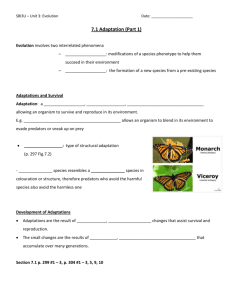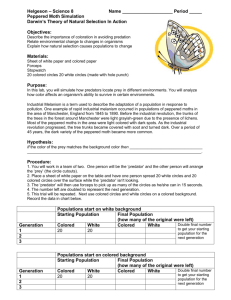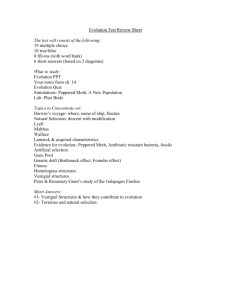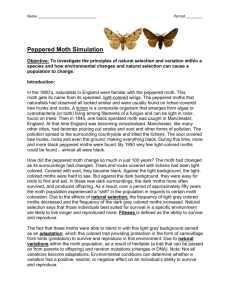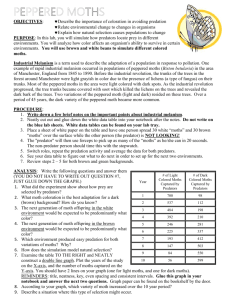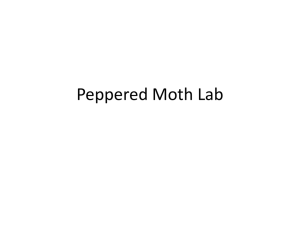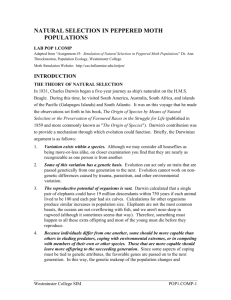Lab: Peppered Moth Simulation
advertisement
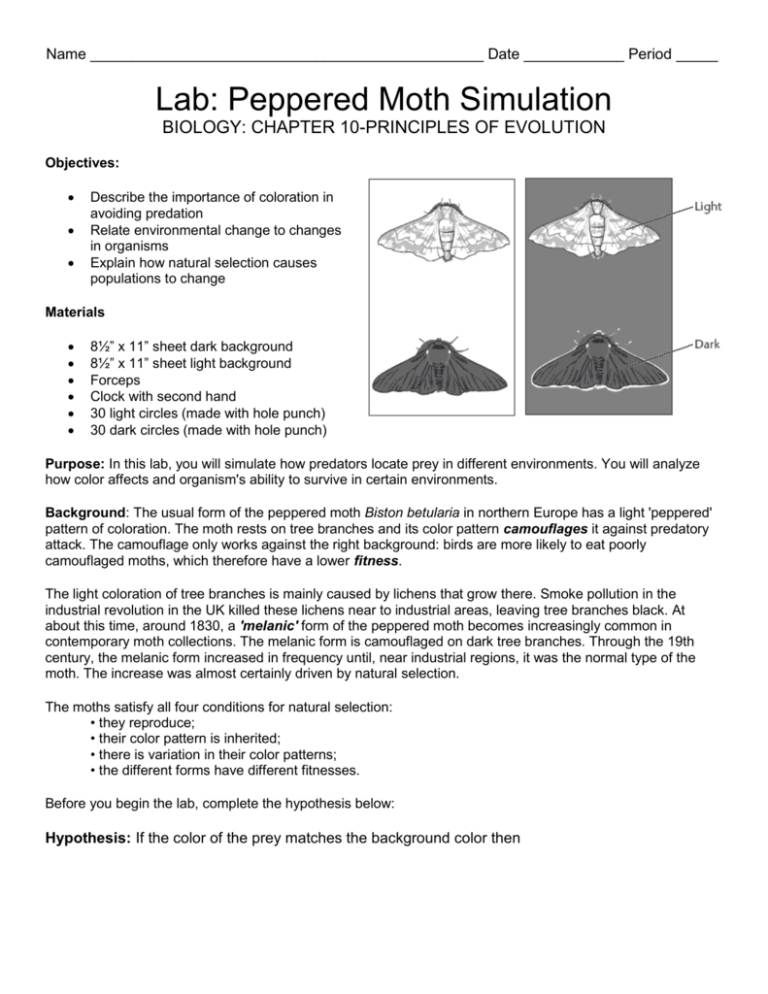
Name _______________________________________________ Date ____________ Period _____ Lab: Peppered Moth Simulation BIOLOGY: CHAPTER 10-PRINCIPLES OF EVOLUTION Objectives: Describe the importance of coloration in avoiding predation Relate environmental change to changes in organisms Explain how natural selection causes populations to change Materials 8½” x 11” sheet dark background 8½” x 11” sheet light background Forceps Clock with second hand 30 light circles (made with hole punch) 30 dark circles (made with hole punch) Purpose: In this lab, you will simulate how predators locate prey in different environments. You will analyze how color affects and organism's ability to survive in certain environments. Background: The usual form of the peppered moth Biston betularia in northern Europe has a light 'peppered' pattern of coloration. The moth rests on tree branches and its color pattern camouflages it against predatory attack. The camouflage only works against the right background: birds are more likely to eat poorly camouflaged moths, which therefore have a lower fitness. The light coloration of tree branches is mainly caused by lichens that grow there. Smoke pollution in the industrial revolution in the UK killed these lichens near to industrial areas, leaving tree branches black. At about this time, around 1830, a 'melanic' form of the peppered moth becomes increasingly common in contemporary moth collections. The melanic form is camouflaged on dark tree branches. Through the 19th century, the melanic form increased in frequency until, near industrial regions, it was the normal type of the moth. The increase was almost certainly driven by natural selection. The moths satisfy all four conditions for natural selection: • they reproduce; • their color pattern is inherited; • there is variation in their color patterns; • the different forms have different fitnesses. Before you begin the lab, complete the hypothesis below: Hypothesis: If the color of the prey matches the background color then Procedure. 1. You will work in a team of two. One person will be the ‘predator’ and the other person will arrange the ‘prey’ (the cutouts). 2. Place a sheet (dark background) on the table and have one person spread 30 dark cutouts and 30 light colored cutouts over the surface while the ‘predator’ isn't looking. 3. The "predator" will then use forceps to pick up as many of the cutouts as he/she can in 15 seconds. Imagine yourself as a ‘predator’ in the wild. 4. The number that are left are doubled to represent the next generation 5. This trial will be repeated for 5 generations. Next use light and dark cutouts on a light colored background. Record the data in the table below. Populations Start on Dark Background Starting Population Final Populations (how many of the original were left ) Generation Light colored Dark colored 1 30 Light colored Dark colored 30 Double these final numbers to get your starting population for the next generation 2 3 4 5 Populations Start on Light Background Starting Population Generation Light colored Dark colored 1 2 3 4 30 30 Final Populations (how many of the original were left ) Light colored Dark colored Double these final numbers to get your starting population for the next generation 5 Analysis: 1. Describe how the population of “moths” changed in each generation for both the light and the dark colored moths. 2. What moth coloration is the best adaptation for a dark background? How do you know? 3. How does the simulation model natural selection? 4.Was your original hypothesis correct? (If not, form a new hypothesis. Remember that your hypothesis should be an “if/then” statement) 5.Are the light and dark colored moths different species? How can you tell? 6. What characteristic provided fitness for the peppered moths? 7. How do changes in an organism’s genes (such as the gene for dark colored wings in the peppered moth) come from? 8. Do you think the dark colored moth was also the predominant form found in the countryside that was not effected by pollution during the Industrial Revolution? (Explain) 9. What form of peppered moth do you think is most prevalent now in and around the large cities in England? (Explain) 10. What characteristic of a population is most important in order for the population to survive a constantly changing environment? Conclusion: Write a minimum 5 sentence summary of a) what the experiment tested and showed b) how the experiment relates to natural selection c) how the experiment is an example of evolution (gradual change). Use the space below:


